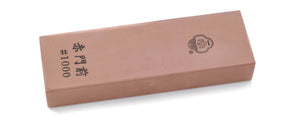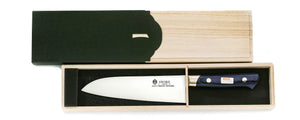
A finishing stone that is a little rougher than the others.
Can be used with any type of steel. Best for quick finishig. Also, it can be used by just pouring water on it.
Even when combined with a slightly rougher (#800-1000) stone, it can easily remove scratches from the medium sharpening step and finish the knife.
If you want to remove scratches made by rough or medium sharpening step, you can use this stone and then use a fine finishing stone to achieve a beautiful mirror finish.
With base, it can be used stably.
Product No:14k3000-d
Size without base : 75x205x25mm
Grit Size: #3000
Nagura Stone and Wooden Base are included.
*Nagura Stone (or Dressing Stone) is a small stone for creating slurry before sharpening a knife and erasing the metal attached on the whetstone after the sharpening.

How to Choose a Whetstone
Sharpening your knives is as important as using them, but there's so many whetstones to pick from!
Here's how to buy your first.

Fine Stone
The number is 2000 - 10000 grit and can go even further beyond.
This type of stone is used for the final process of sharpening. You may seem them sometimes referred to as "finishing stones."
It is so fine that can sharpening using this whetstone can even remove the scratches from a medium stone.
It is often used for Japanese knives (such as Yanagiba knives), which require extremely delicate sharpness.

Resinoid
Manufacturing Method
Synthetic resins such as phenol and epoxy are hardened by baking at a relatively low temperature of around 200℃. The stone has low water absorbency, so there is no need to soak it in water before sharpening. The elasticity of the whetstone makes it easy to hit the blade when sharpening and produces a fine, fine finish. This method is suitable for medium to fine stones.
A knife store that has supported the history of knives and food culture in Japan.
It has been 600 years since the birth of swordmaking in the Sakai region of Japan. Sakai Ichimonji Mitsuhide's and it's craftsmen continue to build on that legacy by producing the finest blades in Japan.
This is where the culture of completing a dish of sashimi by "just cutting" and the culture of expressing sharpness as "taste" was born.
For 70 years, we have been connecting the spirit of Sakai's craftsmen with the passion of chefs in Osaka's kitchen equipment shopping district, known as the kitchen of Japan.
We are very happy that our knives can be used by people all over the world.

How to Choose a Japanese Kitchen Knife for Beginners
Japanese kitchen knives are famous for their design, history, and cutting performance. This guide will help you select the best knife for your needs.































